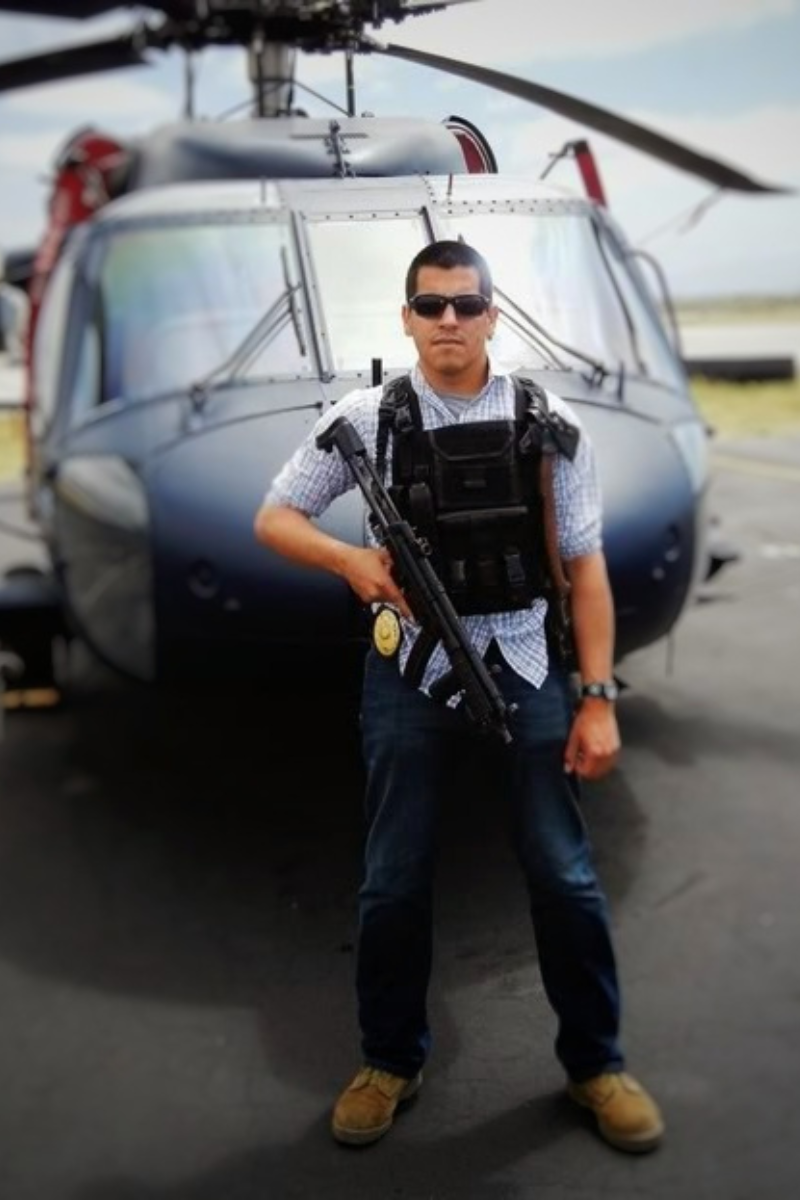Watching Ed Calderon move through the dense streets of Tijuana is a speed lesson in street smarts: the grey man but the savvy observer, the dutiful dad but the vigilant hawk. Yet, even through my several years of knowing the former Mexican police officer turned security and cartel expert, I never cease to be surprised: the detailed knowledge, the ability to draw on names and nuances, the rich understanding of how every inch of the cartel and corruption factory operates south and north of the notoriously clogged border is next to none.
“We’re hinging on a military dictatorship here,” Ed tells me darkly from the Mexican state of Baja California, over the border from the sunny beach city of San Diego.
The phrase sends chills down my spine. After all, Ed is now one of the U.S’s most sought-after security consultants, with classes and courses spanning escapology, anti-abduction, unarmed combat, executive protection and unconventional weapons work for civilians, military and government employees across the board.
Born in Tijuana, Mexico, right in the middle of Seventh Street – a spot notorious for feeding Americans the booze they couldn’t get up north during the Prohibition era of 1920 to 1933 – Ed remembers an idyllic childhood.
“There wasn’t much crime, no cartels shooting each other. I grew up skateboarding,” the 40-year-old recalls with light affection. “It was a pretty good childhood.”

However, things took an ominous turn in the 1990s when cartel-on-cartel, cold-blooded shootouts erupted on the streets, with bloodied and broken bodies appearing in sewers and sidewalks. Still, the self-described “long-haired kid into punk rock” enrolled in medical school after high school. But during his second year, al Qaeda operatives slammed planes into New York’s Twin Towers. The subsequent downturn in the economy and shuttering of borders sent his parents’ construction business spiraling, and they could no longer afford the tuition fees.
“Suddenly, people like me didn’t have opportunities anymore. It was working in a call center or working for the cartel,” Ed says. “A lot of my friends went to work for the cartels.”
However, the wide-eyed youngster did find another route in 2004: he joined an “experimental new police force” the Mexican state was piecing together. Ed describes it as a law enforcement unit built from the ground up, established on the structure of an American police force complete with intelligence-gathering, surveillance, and military-like capabilities. Every applicant had to pass an FBI background check, with investigators digging into one’s financials and family history, ensuring that the hopeful was not compromised or ordered to infiltrate by the increasingly powerful cartels. In addition, every contender had to pass detailed psychological evaluations, tattoos got you disqualified, and even those who were married or had children were sent home.
“When I eventually got the call back, I had to turn up with only a backpack filled with a few personal items alongside a bunch of men and women around my age. And we found ourselves in a Baja prison on a hill that didn’t meet the requirements when the building was finished,” Ed recounts. “It wasn’t good enough for a prison, but it was good enough for a police academy.”
Basic training lasted around seven months; almost every day, a grueling 18 hours – learning everything from guerrilla warfare to penal code arrest procedures. Ed was eventually assigned to the special operations wing of the police, at the helm of new efforts to combat cartel activities during the dawn months of the Felipe Calderon administration.
Initially, the tight selection and rigorous training served the new forces well.
“We earned a reputation for being the people who were equipped and would show up,” Ed points out.
But over time, as what seems to have happened with Mexico’s law enforcement across the board, leadership changed, and handshakes happened behind dirty doors. The elite unit was steadily eroded, infiltrated by the enemy, and police officers – including Ed – would receive threatening messages. Moreover, they were targeted explicitly while out in the open fields. In his words, it became “open hunting season.”
“This kind of changed the morale; people didn’t want to show up for work anymore. Police were worried about their families, and the work faltered, which led to many people flipping sides within our police units,” he laments. “So, there was obviously somebody within our force feeding them (the cartels) information.”
Morale plummeted even further when police were stripped of high-powered weaponry and sent to the firing line, sometimes running out of ammunition. Directors came in and out, and everyone was suddenly “suspect” and, despite all they had devoted, were under investigation for cartel links. The tipping point came for Ed in 2016, when he was given an ultimatum that to keep his senior position, he needed to “work for a side.”
“I walked out, handed in my resignation, and put my stuff neatly into the locker,” Ed tells me. “Then I picked up my daughter and drove my truck across the border to the United States.”
More than eight years ago, Ed (now a U.S. Permanent Resident) started putting his skills and observations to broader use via classes and anonymously on social media, the wildly popular “Ed’s Manifesto.”
“The name was given to me by a Navy SEAL friend. Every time I would go on a training cycle with him, he would see me take out the notebook and all the handwritten notes I kept,” Ed says with a smile. “He would ask what I was writing in Ed’s Manifesto.”
Ed realized that he had amassed a vast amount of information on everything from how the cartels would strategize controlling a whole city to how they made improvised armored vehicles and concealed their drugs and guns, along with access to unique underground videos that a broader audience needed to see.
One day, a Joe Rogan message popped up in his Instagram inbox. After two appearances on his famed podcast – 2019 and 2020 – Ed’s face was to the name, and with a big following.
When I ask about the safe scenario across Mexico now, or more specifically along the shadowy California border region, Ed doesn’t hesitate to respond in melancholy for a moment. From his lens, the horrific levels of violence today directly result from an ill-conceived war-against-drugs policy first ignited by President Nixon in 1971.
“That was based around decapitating the leadership at high levels, which fragmented a lot of the cartels, and then they started creating independent opportunities for new people who didn’t know how to manage their territories,” Ed explains. “It turned into smaller groups of young people wanting to exert violence instead of diplomacy.”
According to the latest research from Mexico’s Center for Economic Research and Teaching (CIDE), at least 150 organized crime gangs are operating across the country. Sadly, many Mexicans have come to understand that organized crime is the most powerful player in the Mexican calamity, its bottom line soaked in bloodshed.
And even though Ed never left his homeland to fire his weapon, the intensity of the shootouts renders him something equivalent to twelve years of continuous, heavy-duty combat deployments. But it’s only in recent years that Ed has come to grips with the toll that has taken, the impact of PTSD on his personal life, and has shared intimate writings with his followers.
“I decided to go through sobriety throughout the past few years. It has brought clarity to all my issues; it is taking off the blindfold and seeing how horrible your house is,” he says carefully. “But it has also brought in a real support network.”
Reigning Mexican President Lopez Obrador, often referred to as AMLO, has said since his tenure in December 2018 that he will fight the cartel conflict with intelligence and not force, which quickly spawned his “Hugs Not Bullets” policy. Unfortunately, the likes of Ed see this as a step in the wrong direction, of which many Mexicans – and Americans – are paying the price.
The U.S. Center for Disease Control and Prevention (CDC) estimates that more than 150 Americans people die yearly from “overdoses related to synthetic opioids like fentanyl.” The way it works is that the precursors come from companies in China, and the cartels use the deadly filler inside everything from heroin and meth to marijuana, cocaine and even standard pharmaceutical pills. The tiniest granule – which cannot be tasted, seen, smelled, or detected – kills.
“We are seeing trench warfare; nothing is being done about it. Fentanyl is everywhere. It is something being pumped into the world, and it is going right through the ports of entry in Mexico right now,” Ed cautions. “The big move is using it in pain medication pills on an industrial level. It is going through conventional, regulated pharmaceutical companies, and there is no real effort by the Government to stop it.”
One would logically think it is bad for business for cartel operatives to kill off their clientele carelessly daily. However, as Ed bluntly puts it, they “don’t give a shit about the clients. Their only job is to give the product to a distributor up north.”
Further, data presented to ALMO in July highlighted that 2022 is on track to be one of the most violent in decades, with 15,4000 murders in the first six months alone.
Beyond the drug woes and homicide epidemic, the swelling border crisis also presents a business haven for human traffickers and kidnaps. The cartels also have a significant role and financial stake. As it stands, Mexico has one of the world’s worst crises of women and children forced into prostitution. While extensive trafficking has been around for centuries, the affiliated brutality with the illicit drug business has even curved out of control.
According to the U.S. Government’s 2022 Trafficking in Persons Report for Mexico, the Mexican Government is trying to stop the violating practice but “does not fully meet the minimum standards for the elimination of trafficking.”
“The government failed to allocate funds to a legally-required victim assistance fund; authorities did not consistently employ a victim-centered approach, and overall services for victims were inadequate,” the report noted.
In reality, almost everyone knows that the law enforcement establishment is too dull a tool for the impossibly powerful cartels. Yet when it comes to making inroads in stopping the surge of criminal entities claiming countless American lives, Ed remains firm that even more of an iron fist is needed. First, he cautions Washington to wade with high caution when dealing with their Mexico City counterparts to curb the matter.
“Any drug policies, any sort of drug or counter-cartel policy related to Mexico should not include the Mexican military or Government. They are not to be trusted,” Ed warns. “All the funds and money being sent to Mexico for programs and training, American tax dollars, and it is only getting worse. The politics in Mexico are completely anti-American.”
He takes a short, frustrated breath.
“These cartel organizations meet every single definition of a terrorist organization. They do political assassinations; they have their candidates running,” Ed stresses, citing several examples of officials exposed for cartel connections. “Meanwhile, the U.S. is fighting terrorist organizations they view as attacking their interests in Northern Africa and the Middle East, but here you have organizations working hand-in-hand with Chinese interests and putting fentanyl up to kill a generation of young people, and yet nothing changes.”











